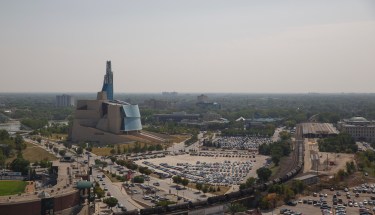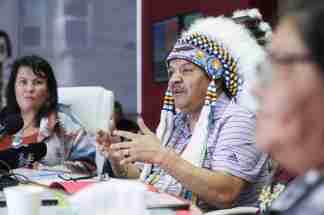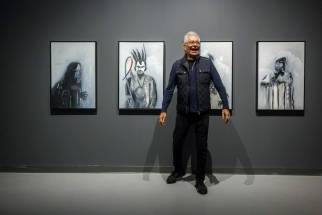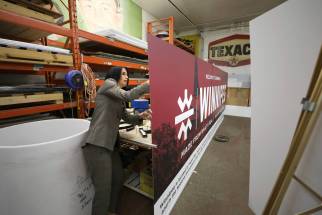A captivating collection Robert Houle’s 50-year retrospective at the WAG a return to where it all began
Read this article for free:
or
Already have an account? Log in here »
To continue reading, please subscribe:
Monthly Digital Subscription
$0 for the first 4 weeks*
- Enjoy unlimited reading on winnipegfreepress.com
- Read the E-Edition, our digital replica newspaper
- Access News Break, our award-winning app
- Play interactive puzzles
*No charge for 4 weeks then price increases to the regular rate of $19.00 plus GST every four weeks. Offer available to new and qualified returning subscribers only. Cancel any time.
Monthly Digital Subscription
$4.75/week*
- Enjoy unlimited reading on winnipegfreepress.com
- Read the E-Edition, our digital replica newspaper
- Access News Break, our award-winning app
- Play interactive puzzles
*Billed as $19 plus GST every four weeks. Cancel any time.
To continue reading, please subscribe:
Add Free Press access to your Brandon Sun subscription for only an additional
$1 for the first 4 weeks*
*Your next subscription payment will increase by $1.00 and you will be charged $16.99 plus GST for four weeks. After four weeks, your payment will increase to $23.99 plus GST every four weeks.
Read unlimited articles for free today:
or
Already have an account? Log in here »
Hey there, time traveller!
This article was published 06/10/2022 (1158 days ago), so information in it may no longer be current.
Robert Houle’s artistic career comes full circle in a new exhibition that opens today at the Winnipeg Art Gallery.
Titled Robert Houle: Red is Beautiful, the show is a 50-year retrospective of the Anishinaabe Saulteaux contemporary artist who was born in St. Boniface in 1947, was the gallery’s artist-in-residence in 1989 and where some of his first major exhibitions were shown.
“I basically grew up in this gallery,” Houle said at an unveiling for the media Thursday. “I was nurtured by the curatorial staff of this gallery so it’s very important, very personal to me, this gallery.”
MIKE DEAL / WINNIPEG FREE PRESS Robert Houle learned how to draw in residential schools in Sandy Bay and in Winnipeg; a priest at the Assiniboia residential school gave him some money to take art classes at Polo Park.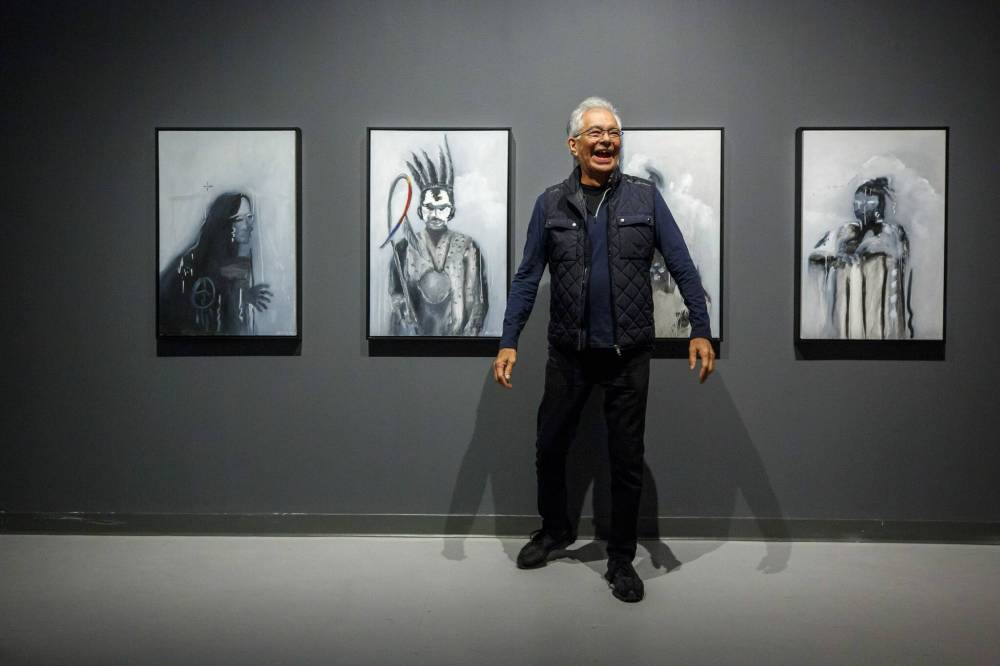
He learned how to draw in residential schools in Sandy Bay, about 175 kilometres northwest of Winnipeg, and later at the Assiniboia residential school on Academy Road, and he remembered a priest there gave him some money to take art classes in Polo Park.
That led to Houle attending the University of Manitoba, and later McGill University in Montreal, where his art career began to flourish.
Works from his WAG residence led to the 1990 exhibition Robert Houle: Indians from A to Z.
Another exhibition, 1999’s Robert Houle: Sovereignty over Subjectivity, led to his most notable contribution to the WAG and its permanent collection.
It greets visitors the moment they step inside the third-floor main gallery that houses Robert Houle: Red is Beautiful.
“I basically grew up in this gallery. I was nurtured by the curatorial staff of this gallery so it’s very important, very personal to me, this gallery.”–Robert Houle
Sandy Bay, a 1999 installation, includes two photographs — one of a priest and another of Indigenous schoolchildren — a blue-toned misty painting of the residential school, a dark blue strip that signifies Lake Manitoba and an abstract landscape in mostly in red.
Senator Patricia Bovey, who was the WAG’s director from 1999-2004 and remains a director emeritus at the gallery, helped raised money to purchase Sandy Bay, which she says is “one of the most important paintings in the annals of Canadian art history.
“What really moves me about that piece is there are no doors, and the windows are veiled,” she says in a telephone interview from Ottawa. “Robert and his sisters were taken to that residential school and they never had recess together and they didn’t see each other.
“It brought out his buried feelings, the raw emotions he had.”
Winnipeg Art Gallery Sandy Bay, 1998–1999. Oil, black and white photograph, colour photograph on canvas, Masonite, 300 x 548.4 cm. Collection of the Winnipeg Art Gallery.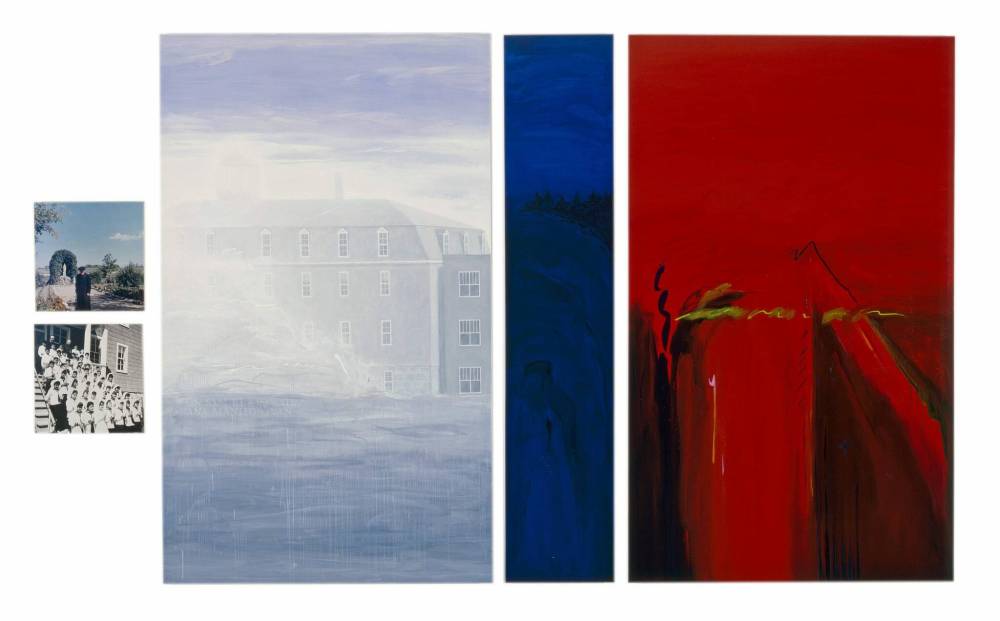
During a tour of exhibition on Oct. 6, Houle mentioned that he would look forward to weekends when he would be able to return home and rejoin his family, including his sisters he wasn’t allowed to see in school.
It allowed them to continue learning Anishinaabe language and culture but also escape the school, even if it was just on weekends.
”We would run home, we would sing and laugh all the way home because we were not allowed to speak Anishinaabe,” he says. “There was some kids we knew who were friends of ours who had to stay there all summer, they were orphans or came from broken families, and I knew those kids were abused.”
MIKE DEAL / WINNIPEG FREE PRESS Wanda Nanibush, curator of Indigenous art at the Art Gallery of Ontario, who assembled Houle’s works for Red is Beautiful.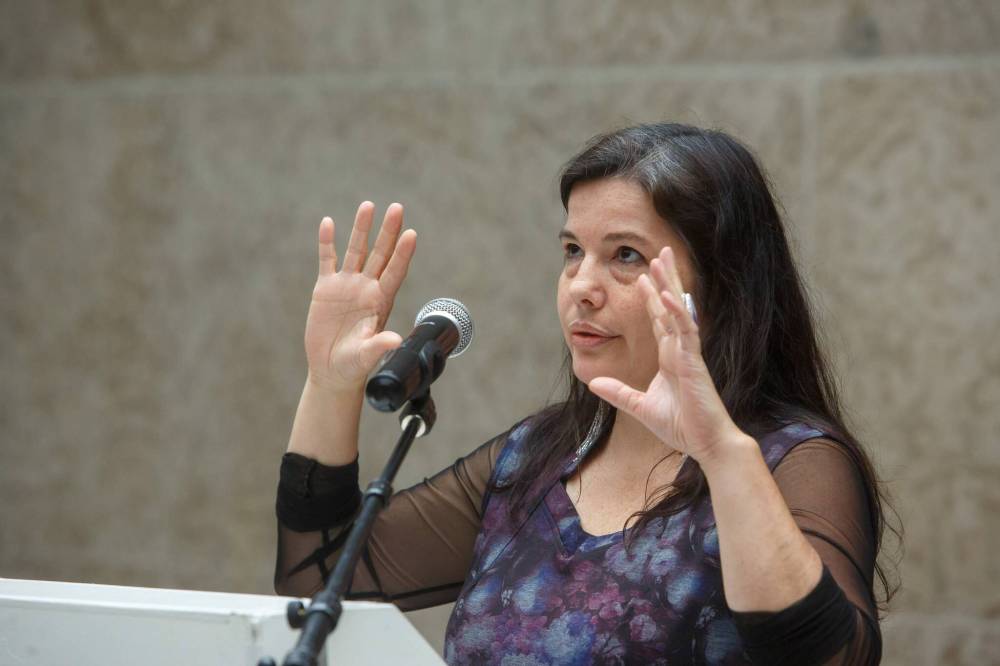
Houle’s works aren’t only internal, says Wanda Nanibush, the curator of Indigenous art for the Art Gallery of Ontario, who has assembled Houle’s works for Robert Houle: Red is Beautiful.
They also are a response to historic moments, such as the Oka crisis in 1990 and the Ipperwash land dispute in 1995, as well as many aspects of colonization that have affected Indigenous people across the country.
“You’ll see the trajectory that he has built in his work about our resistance, about our land rights movement, all of that is in his work,” says Nanibush.
Near to Sandy Bay are two more large Houle paintings, Kanata, from 1992, and O-ween du muh waun, from 2017, both of which are inspired by the 1770 Benjamin West painting The Death of General Wolfe, which is an artistic rendering of the British general’s death during the Battle of the Plains of Abraham in Quebec.
Robert Houle O-ween du muh waun (We Were Told), 2017. Oil on canvas, triptych, 213.4 x 365.8 cm. Collection of the Confederation Centre Art Gallery. Commissioned with the A.G. and Eliza Jane Ramsden Endowment Fund, 2017.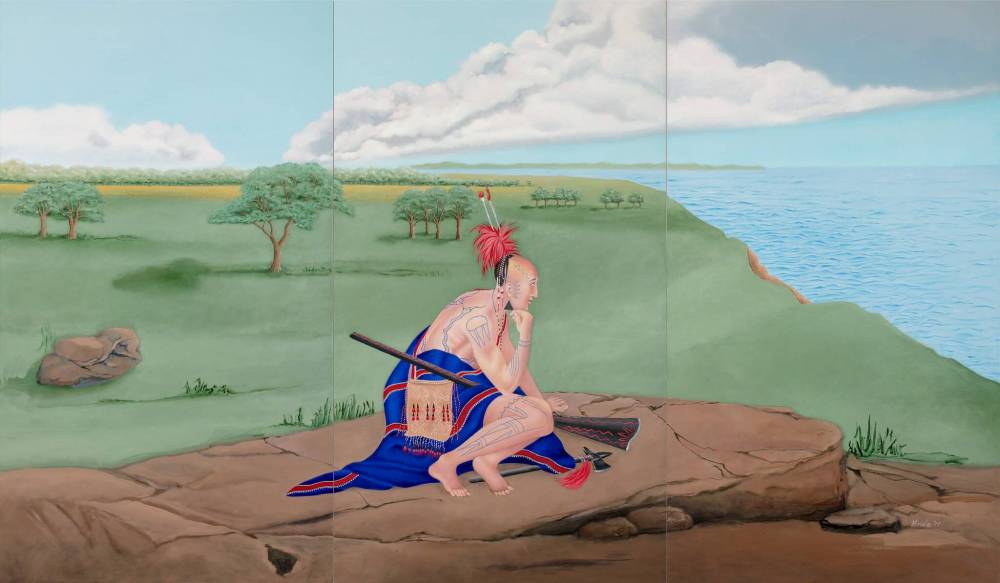
Among the throng of people watching the dying general in West’s painting is an Indigenous warrior; in Houle’s Kanata, only the warrior is painted in colour.
Houle revisited West’s painting again 25 years later, only this time all the French and English forces are gone, leaving the kneeling warrior gazing out onto the sea.
Serge Gumenyuk photo Parfleche #5, Philip, from the series Parfleches for the Last Supper, 1983. Acrylic, porcupine quill on paper, 56 x 56 cm. Collection of the Winnipeg Art Gallery. Gift of Mr. Carl T. Grant, Artvest Inc.
Besides his painting, Houle has been a teacher, university professor of art, museum curator and an advocate for other Indigenous artists in Canada including Norval Morrisseau (whose portrait is part of Robert Houle: Red is Beautiful), Alex Janvier and Winnipeg-based artist Daphne Odjig.
Houle led a movement against curators who included contemporary art by Indigenous people in the Canadian Museum of Civilization rather in the National Gallery of Canada, saying art isn’t artifacts.
“I wasn’t angry. I was just aware that there was something amiss. There was discrimination,” Houle says in a telephone interview prior to arriving in Winnipeg. “Contemporary native art activity was geared toward ethnological collections, and I resented that and I fought that.
“It’s OK now, I’m happy I did that. It made me appear as a two-headed monster, but I didn’t care because if you care about art, you’ll do anything to defend it.”
Serge Gumenyuk photo Parfleche #7, Bartholomew, from the series Parfleches for the Last Supper, 1983. Acrylic, porcupine quill on paper, 56 x 56 cm. Collection of the Winnipeg Art Gallery. Gift of Mr. Carl T. Grant, Artvest Inc.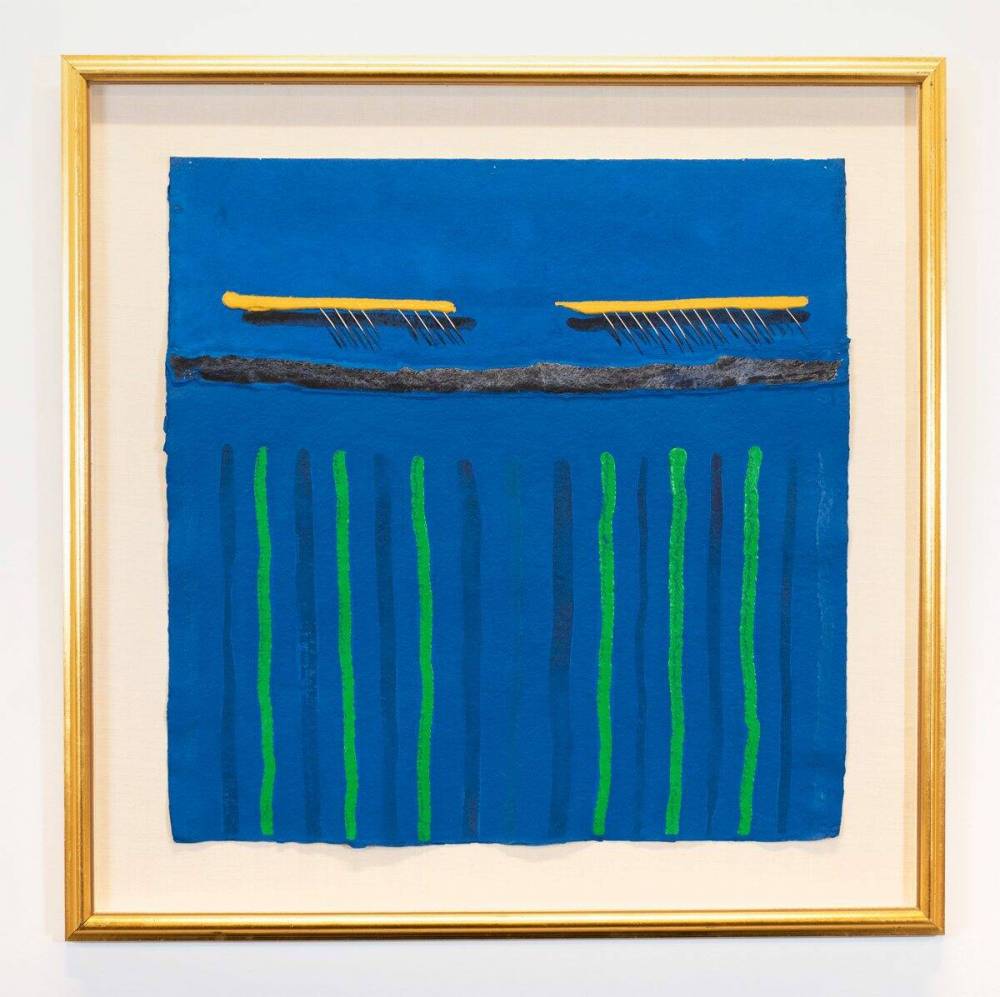
Stephen Borys, the director and chief executive officer of WAG-Qaumajuq, who will take part with Houle and Nanibush in a “conversation with the artist” event Saturday at 2 p.m. at the gallery, says Houle’s art has helped him on his own path toward truth and reconciliation.
“His artwork has much to do about ourselves, about our land, about reconciliation and the themes, the symbolism,” he says. “The artistry of his work, they mix, they converge with emotion-filled explorations of a range of ideas and subjects and stories.”
Robert Houle: Red is Beautiful is named after the first work Houle sold, a piece that includes weaving and beadwork patterns he created while he was an arts student at McGill. He says he got paid $90, which helped him believe he could pursue art as a career.
It’s part of the exhibition, but visitors will need to keep their eyes peeled for it.
“It’s funny because people go hunting around for that work, and it’s the smallest work in the show,” she says. “It surprises people to no end.”
Alan.Small@winnipegfreepress.com
Twitter: @AlanDSmall
Art preview
Robert Houle: Red is Beautiful
By Robert Houle
● Winnipeg Art Gallery
● Opens today, to March 27, 2023

Alan Small has been a journalist at the Free Press for more than 22 years in a variety of roles, the latest being a reporter in the Arts and Life section.
Our newsroom depends on a growing audience of readers to power our journalism. If you are not a paid reader, please consider becoming a subscriber.
Our newsroom depends on its audience of readers to power our journalism. Thank you for your support.

